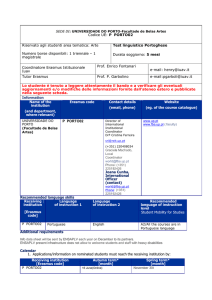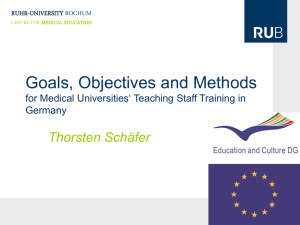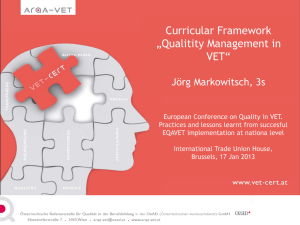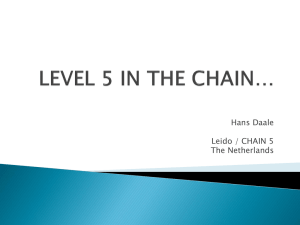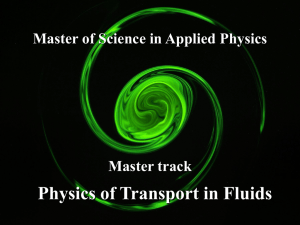ppt2 - Bologna Process
advertisement
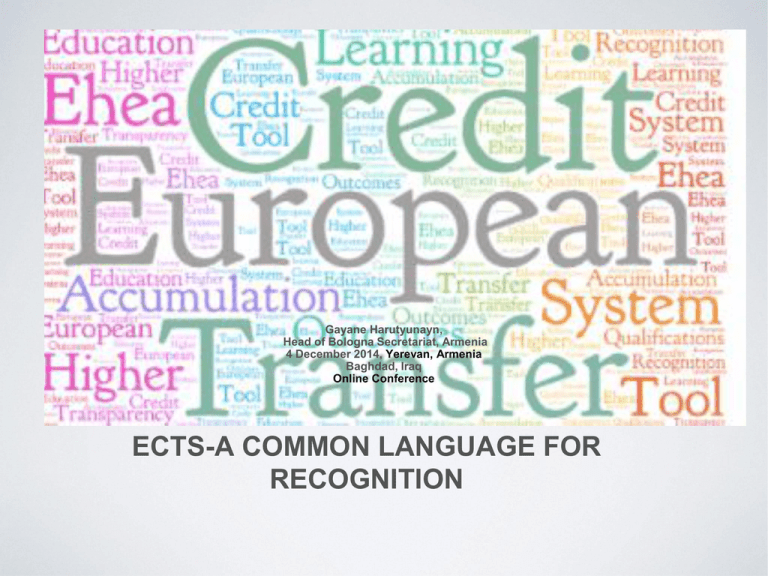
Gayane Harutyunayn, Head of Bologna Secretariat, Armenia 4 December 2014, Yerevan, Armenia Baghdad, Iraq Online Conference ECTS-A COMMON LANGUAGE FOR RECOGNITION ECTS-EUROPEAN CREDIT TRANSFER & ACCUMULATION SYSTEM BRIEF HISTROY-HOW DID IT DEVELOPED? • 1989 EU Pilot: ECTS was introduced as a pilot scheme in ERASMUS Program (145 HEI, 5 subject areas). • 1999: Bologna Declaration identified ECTS as a tool to be used for all students rather than for purposes of recognition. • 2002 EUA Zürich conference: endorsed the central role of ECTS in higher education: accumulation& transfer;workload and learning outcomes. • ECTS is adopted as the national credit system in majority of the Bologna countries and most of them have done it by law. TOOLS FOR RECOGNITION: MUTUALLY INTERLINKED • Lisbon Recognition Convention • Diploma Supplement • ENIC-NARIC Network, etc. • EAR-Manual • ECTS • European Standards and Guidelines for Quality Assurance • National QA systems • Overarching Qualifications Frameworks: QF-EHEA and EQF for LLL • National qualifications frameworks– can contain more detailed national credits • Learning outcomes • arrangements ECTS USER’S GUIDE: GUIDELINES FOR IMPLEMENTATION • 1994 -ECTS for transfer • 2005-ECTS for accumulation and transfer • 2009 -ECTS for accumulation and lifelong learning • 2015 -ECTS will take into account recent developments: establishment of EHEA, consolidation of lifelong learning; learner-centred HE; increasing role of learning outcomes, etc. *Further slides are based on 2009 ECTS Users’ Guide. STRUCTURE OF THE GUIDE(2009) • Six parts: introduces ECTS as a tool, its operational principles and the contexts in which it is used • References for further reading • Glossary • Five annexes: • Learners’ perspective in using ECTS Suggestions on recognition ECTS Grading table Standard key documents Overview of national regulations MAIN PARTS OF THE GUIDE • ECTS credit allocation • Awarding credits • ECTS credit accumulation & progression • Credit transfer in ECTS • ECTS & LLL • ECTS as a learner-centred credit system • ECTS & LOs • ECTS, levels & level descriptors • ECTS credits & workload Key Features Tools-Key documents • • • • Course Catalogue Students application form Learning agreement Transcript of records PrinciplesImplementing in HEIs QA & ECTS QFs & ECTS ECTS KEY FEATURES • ECTS system now turned to a learner-centred system for credit accumulation and transfer based on the transparency of learning outcomes and learning processes. • Widely used in formal higher education and can be applied to any mode of delivery (full-time, part-time, distance learning). • An instrument to facilitate planning, delivery, evaluation, recognition and validation of prior learning and their parts (e.g. modules, course components, work placements, thesis, etc.) & learner mobility • This approach opens possibilities to use the ECTS credit system for other activities as well (lifelong learning, i.e. prior learning – non-formal education and/or informal learning) • ECTS credits are based on the workload students need in order to achieve expected learning outcomes • 60 credits are attached to the workload of a full‐time year of formal learning and associated learning outcomes • Student workload ranges from 1500 ‐1800 hours for an academic year; (38‐42 weeks) • 1(one) credit corresponds to 25‐30 hours or work LEARNING OUTCOMES(LO) • LOs describe what a learner is expected to know, understand and be able to do after successful completion of a process of learning. They relate to level descriptors in national and European qualifications frameworks • LOs are explicit statements about the outcomes of learning, i.e. the results of learning – two possible approaches exist: may be either threshold statements ( showing min. requirement to obtain a pass) or reference points ( showing the expected level of achievement of learners). • LOs demonstrate a particular methodological approach for the expression and description of the curriculum (modules, units and qualifications) and levels, cycles, subject benchmark statements and the ‘new style’ qualifications frameworks. • LOs are defined before credit allocation; ECTS credits are allocated on the basis of “the workload students need to achieve expected learning outcomes” QUALITY ASSURANCE • ECTS credits are in line with European Standards and Guidelines for QA • ECTS should be part of the QA of programmes and awards at institutional & national level. • It is expected to include: • explicit LOs (to all educational components)–must be clear which approach is used, • curriculum and programme design and content, • methods of delivery and assessment, • HEIs should regularly publish up-to-dates ,impartial and objective information, both quantitative and qualitative on programmes and awards they are offering. • Implementation and use of ECTS by HEIS should be quality assured through appropriate process (internal and exrternal QA, feedback from students, etc.). FOR RECOGNITION • Qualifications as well as their educational components are expressed in terms of appropriate learning outcomes and clear information is available concerning their level, credits, delivery and assessment. • Credit transfer processes are included in monitoring, review and validation procedures (in the internal regulations of the HEI). • Trained staff with understanding of transfer of ECTS credits and recognition principles (‘fair ’ recognition and not 1-1 equivalence). • Clear Learning agreements, any changes should be approved. • Mobile students take learning activities from the Course Catalogue; follow the regime of home students. • Detailed transcript should be provided. • Recognition given to all credits awarded for fulfilled learning activities agreed in Learning Agreement. QUALIFICATION FRAMEWORKS ECTS credits are part of qualifications frameworks • Overarching Qualifications Framework for European Higher Education Area (QFEHEA) • ECTS credits associated with • 1st cycle (usually called Bachelor): 180 – 240 ECTS; (according to national context „short cycle“ within the 1st cycle – 120 ECTS) • 2nd cycle (usually called Master): 90-120 ECTS, minimum 60 ECTS gained at Master's level • National qualifications frameworks – can contain more detailed national credit arrangements • High potential for recognition of prior learning; lifelong learning concept BENEFITS OF ECTS • Enables students to move freely for study and work • Builds trust and transparency between HE systems • Improves relevance and flexibility of curriculum • Emphasises learning outcomes • Encourages shift to a learner-centred approach • Facilitates flexible learning pathways, lifelong learning and the use of new methods of learning and teaching • Underpins shift to programmes developing skills and competences relevant to the needs of society. Thank you for your attention!


